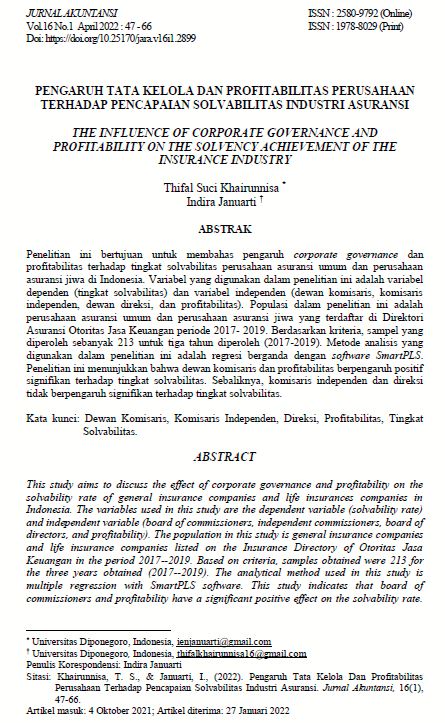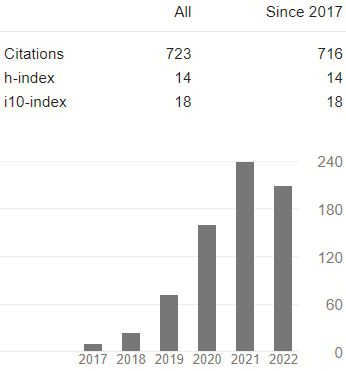PENGARUH TATA KELOLA DAN PROFITABILITAS PERUSAHAAN TERHADAP PENCAPAIAN SOLVABILITAS INDUSTRI ASURANSI
DOI:
https://doi.org/10.25170/jak.v16i1.2899Keywords:
Board of Commissioners, Independent Commissioners, Directors, ProfitabilityAbstract
This study aims to discuss the effect of corporate governance and profitability on the solvability rate of general insurance companies and life insurances companies in Indonesia. The variables used in this study are the dependent variable (solvability rate) and independent variable (board of commissioners, independent commissioners, board of directors, and profitability). The population in this study is general insurance companies and life insurance companies listed on the Insurance Directory of Otoritas Jasa Keuangan in the period 2017--2019. Based on criteria, samples obtained were 213 for the three years obtained (2017--2019). The analytical method used in this study is multiple regression with SmartPLS software. This study indicates that board of commissioners and profitability have a significant positive effect on the solvability rate
References
Akbar, S., Kharabsheh, B., Poletti-Hughes, J., & Shah, S. Z. A. (2017). Board structure and corporate risk taking in the UK financial sector. International Review of Financial Analysis, 50, 101–110. https://doi.org/10.1016/j.irfa.2017.02.001
Bozec, R., & Dia, M. (2017). Monitoring function of the board and audit fees: Contingent upon ownership concentration. In International Journal of Accounting and Information Management. https://doi.org/10.1108/IJAIM-05-2016-0054
Brigham, F. E., & Houston, J. F. (2013). Dasar-dasar Manajemen Keuangan. Jakarta: Salemba Empat.
de Haan, L., & Kakes, J. (2010). Are non-risk based capital requirements for insurance companies binding? Journal of Banking and Finance, 34(7), 1618–1627. https://doi.org/10.1016/j.jbankfin.2010.03.008
Elabed, I., & Slim, C. (2017). Impact of Firm Specifities and Board Characteristics on Corporate Financial Leverage: Case of Tunisian Listed Firms. Proceedings of ISER International Conference, July, 1–5.
Elamer, A. A., AlHares, A., Ntim, C. G., & Benyazid, I. (2018). The corporate governance–risk-taking nexus: evidence from insurance companies. International Journal of Ethics and Systems. https://doi.org/10.1108/IJOES-07-2018-0103
Ghozali, I., & Latan, H. (2015). Konsep, Teknik, dan Aplikasi Menggunakan Program SmartPLS 3.0 Untuk Penelitian Empiris. Semarang: Badan Penerbit Universitas Diponegoro.
Harrington, S. E., & Niehaus, G. (2004). Risk Management and Insurance. New York: McGraw-Hill.
Jensen, M. (2001). Value maximisation, stakeholder theory, and the corporate objective function. European Financial Management. https://doi.org/10.1111/1468-036X.00158
Jensen, M. C., & Meckling, W. H. (1976). Theory of the firm: Managerial behavior, agency costs and ownership structure. Journal of Financial Economics. https://doi.org/10.1016/0304-405X(76)90026-X
Komite Nasional Kebijakan Governance. (2011). Pedoman Good Corporate Governance Perusahaan Asuransi Dan Perusahaan Reasuransi Indonesia, 1–50.
Laas, D., & Siegel, C. F. (2013). Basel Accords versus Solvency II - Regulatory Adequacy and Consistency Under the Postcrisis Capital Standards. SSRN Electronic Journal. https://doi.org/10.2139/ssrn.2248049
Lindberg, D. L., & Seifert, D. L. (2015). Risk Management in the Insurance Industry: A Comparison of Solvency II to U.S. Insurance Regulations. Journal of Insurance Issues, 38(2), 233–243.
Myers, S. C., & Majluf, N. S. (1984). Corporate financing and investment decisions when firms have information that investors do not have. Journal of Financial Economics. https://doi.org/10.1016/0304-405X(84)90023-0
Otritas Jasa Keuangan Republik Indonesia. (2016). POJK No.71/POJK.05/2016,Tentang Kesehatan Keuangan Perusahaan Asuransi dan Perusahaan Reasuransi. 50.
Pathan, S. (2009). Strong boards, CEO power and bank risk-taking. Journal of Banking and Finance. https://doi.org/10.1016/j.jbankfin.2009.02.001
Prastiwi, D. (2020). Perjalanan Kasus Jiwasraya hingga Penetapan Tersangka. Www.Liputan6.Com. https://www.liputan6.com/news/read/4155743/perjalanan-kasus-jiwasraya-hingga-penetapan-tersangka
Sari, F. (2020). Masalah klaim masih belum usai, OJK: Penyelesaian AJB Bumiputera harus komprehensif. https://keuangan.kontan.co.id. Diakses 2 November 2020
Scheimesser, G. &. (2008). On the Risk Situation of Financial Conglomerates: Does Diversification Matter? Financial Markets and Portfolio Management, 25, 3–26.
Setiawan, I. (2020). Bedah Kasus Gagal Bayar dan Kerugian PT. Asuransi Jiwasraya (Persero). Jurnal Akuntansi Dan Bisnis Indonesia, 1(1), 34–41.
Sudana, I. M. (2011). Manajemen Keuangan Perusahaan. Erlangga.
Venuti, F., & Alfiero, S. (2016). The Impact of Corporate Governance on Risk Taking in European Insurance Industry. 10(1), 188–194.

Downloads
Published
Issue
Section
License
Authors who publish with this journal agree to the following terms:
- Authors retain copyright and grant the journal right of first publication with the work simultaneously licensed under a Creative Commons Attribution-ShareAlike 4.0 International License that allows others to share the work with an acknowledgment of the work's authorship and initial publication in this journal.
- Authors are able to enter into separate, additional contractual arrangements for the non-exclusive distribution of the journal's published version of the work (e.g., post it to an institutional repository or publish it in a book), with an acknowledgment of its initial publication in this journal.
- Authors are permitted and encouraged to post their work online (e.g., in institutional repositories or on their website) prior to and during the submission process, as it can lead to productive exchanges, as well as earlier and greater citation of published work.














